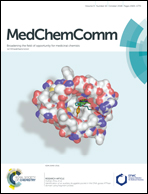Development of a [68Ga]-ghrelin analogue for PET imaging of the ghrelin receptor (GHS-R1a)†
Abstract
The ghrelin receptor is a member of the growth hormone secretagogue receptor (GHS-R) family and is present at low concentrations in tissues such as the brain, kidney, cardiovascular system, and prostate. The ghrelin receptor plays an important role in cellular proliferation, apoptosis, invasion, and migration associated with the progression of many cancers, including prostate, breast, ovarian, testicular, and intestinal carcinomas. Ghrelin, the endogenous ligand, is a 28 amino acid peptide (IC50 = 3.1 nM) known to have poor in vivo stability. Herein, we report the synthesis and evaluation of [Dpr3(octanoyl),Lys19(Ga-DOTA)]ghrelin(1-19). This new ghrelin analogue has a binding affinity (IC50 = 5.9 nM) comparable to that of natural ghrelin. Preliminary in vivo evaluation shows higher uptake of [Dpr3(octanoyl),Lys19(68Ga-DOTA)]ghrelin(1-19) in HT1080/GHSR-1a xenografts than the non-transfected HT1080 xenografts in NOD-SCID mice, although considerable uptake is observed in the kidneys. This is the first example of ghrelin receptor PET imaging in a xenograft model using a peptide derived directly from the endogenous ligand and serves as motivation for developing more effective ghrelin-based radiopeptides.
![Graphical abstract: Development of a [68Ga]-ghrelin analogue for PET imaging of the ghrelin receptor (GHS-R1a)](/en/Image/Get?imageInfo.ImageType=GA&imageInfo.ImageIdentifier.ManuscriptID=C8MD00210J&imageInfo.ImageIdentifier.Year=2018)
- This article is part of the themed collection: Molecular Pharmacology


 Please wait while we load your content...
Please wait while we load your content...